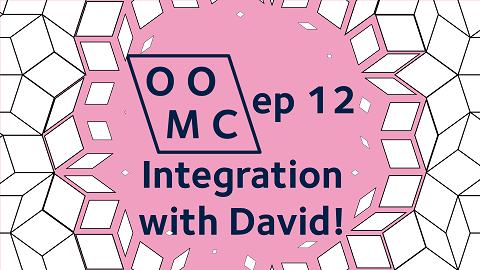Episode 12

In episode 12, David introduces integration by substitution, and James sets him a challenging unseen problem.
Further Reading
Integration by substitution
Here’s a quick summary of integration by substitution on an A-level Maths revision website, if you saw it for the first time in the livestream.
If you want to know where the $r$ comes from when David substitutes into polar coordinates, then you need to know about the Jacobian. That’s university-level mathematics, involving vectors, matrices, multiple integrals, and partial derivatives, all at once. It’s complicated stuff! Here’s a video about the Jacobian by Mathemaniac on YouTube.
Another integration by substitution question
Someone in chat asked for another integral as homework. I assume that you want a difficult one. I searched the internet for tricky integration by substitution questions, and this one kept coming up;$$\int \frac{1+x^4}{1+x^6}\,\mathrm{d}x.$$
I think that this is really hard (you definitely need to know about the integral of $(x^2+1)^{-1}$ to do this), so it’s not something to try if you’ve just learned about integration by substitution.
Three more maths things
Dr Vicky Neale has made friendship bracelets with each of the possible symmetry groups. James Grime interviews Vicky here and Vicky has put more instructions to make these at home on her website here.
Problem Solving Matters is a problem-solving course for Year 12 students from state-funded schools, academies and colleges who are interested in applying for places at Oxford University, Imperial College, Durham University or Warwick University to study Mathematics. Applications have just opened on the AMSP website.
Later this month, Oxford Mathematics are running online Open Days. We’ll have lots of maths content, information about the courses at Oxford, and Q&A with current students and tutors. That’s live 24 April and 01 May at www.maths.ox.ac.uk/open-days.
Curve sketching
I’ve got some 3D curve sketching for you today. In each case, the values of $z$ depend on two inputs, $x$ and $y$, corresponding to points in the $(x,y)$-plane. The function gives the height of a surface above that plane (we’re sketching the surface $z=f(x,y)$).
$$\text{(a)}\quad z=x^2-y,\quad \text{(b)} \quad z=1-x^2-y^2,\quad \text{(c)} \quad z=\sin(x+y)$$
In each case, you might like to sketch the outline of the shape of the curve, show some contours (a curve where $z$ is constant) on the surface, or even do some shading to indicate depth or shadow. Sometimes bits of the surface lie behind other bits of the surface, and it’s up to you whether you do something like drawing those as if the surface is transparent, or with dotty lines, or not at all. If you know how to get a computer program to draw these surfaces, then you’re welcome to do that, but you should examine any choices the programmers have made in how to display the surface. Are there any settings that you can change?
If you want to get in touch with us about any of the mathematics in the video or the further reading, feel free to email us on oomc [at] maths.ox.ac.uk.

